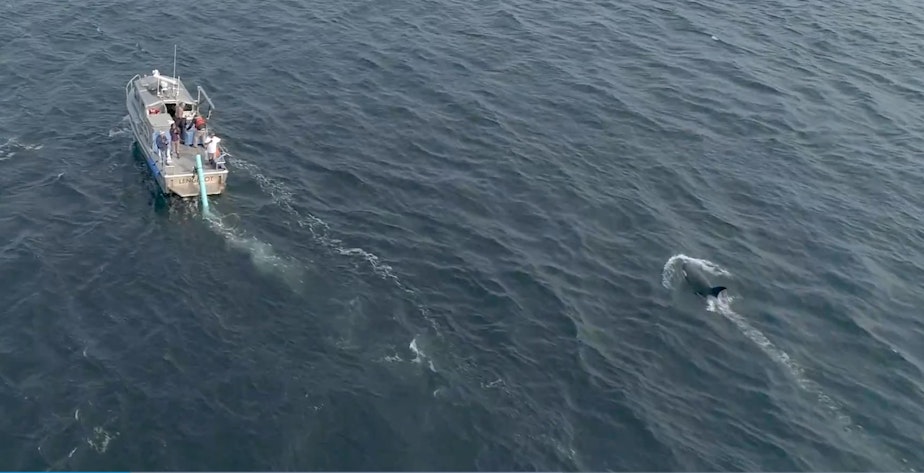Scientists deliver live salmon to sick, endangered orca

Scientists have taken an unprecedented step to save one of the Salish Sea’s 75 endangered orcas: They tried to feed her in the wild.
On board a Lummi Nation police boat off San Juan Island, biologists dropped eight chinook salmon, one by one, into a plastic tube off the boat’s stern on Sunday. The tube disgorged each thrashing fish into the path of the emaciated young killer whale known as J50.
The dinner delivery by boat was a test run for a new way of medicating one of the ocean’s top predators.
"This type of thing has never been tried before, and there were lots of potential things that could potentially go awry,” National Oceanic and Atmospheric Administration biologist Brad Hanson said. “So we were very, very pleased that we were able to do this."
Yet it's unknown whether the 3.5-year-old cooperated and ate her dinner. Hanson said they did not see her change course as she approached the spot, about 100 yards in front of her, where the salmon had been released.
Sponsored
The weekend’s new moon brought strong tides and currents that roiled the waters as well as any evidence of salmon being chomped.
“Any scales or prey remains that would’ve been in the water would’ve been obscured by current,” Hanson said. “It was quite rough in this particular area.”
These salmon, chinooks from the Marblemount Hatchery 78 miles up the Skagit River, had not been medicated, but future deliveries of the orcas’ favorite food could be dosed with antibiotics or other medications.
NOAA Fisheries' drone footage of efforts to diagnose and feed orca J50, Aug. 10 and 12, 2018, off San Juan Island.
Sponsored
Vancouver Aquarium veterinarian Martin Haulena described J50 as "incredibly skinny." He said she had “a very distinct depression behind her head” caused by her lack of blubber.
Scientists don’t know exactly what ails this orca but have observed her emaciation and, over the weekend, her difficulty keeping up with her relatives.
"She was essentially slogging along and not necessarily able to keep up with the rest of the whales," Hanson said. "We haven’t seen her partake in any socialization, where she would be splashing around."
At times, strong tidal currents actually pushed J50 backwards even as she tried to swim forward.
Haulena was part of a crew that used a dart gun and a 10-inch dart to administer a broad-spectrum antibiotic to J50 from 50 feet away on Thursday.
Sponsored
They took the action despite not knowing whether the antibiotic would do any good. Antibiotics do not cure viral diseases, for example.
“If you had one chance of delivering something that would have a likelihood of helping this animal without harming this animal, given what we know, what would it be?” Haulena said. “The consensus was it would be a long-lasting antibiotic.”
Haulena’s medical marksmanship delivered at least a partial dose of the antibiotic Convenia into the whale as it surfaced. Convenia, marketed mainly for skin diseases in dogs and cats, can last up to two weeks in domestic animals.
“We followed this whale for about six hours, and out of six hours, we had probably just two chances,” Haulena said.
He said the dart found its mark, but he noticed some medicine spraying out as the dart hit.
Sponsored
“It’s not an easy target, and their skin is kind of rubbery,” he said.
On Saturday and Sunday, researchers were able to obtain fecal samples that might help them pinpoint any diseases J50 is suffering and what medical treatment to pursue. The main problem: they’re not sure if the sample came from J50, her mother or her sister, since the three were swimming together at the time.
Nor do these extraordinary, emergency measures on behalf of one orca address the problems that have endangered her and her salmon-eating relatives: primarily a dearth of chinook salmon, an excess of toxic pollution and vessel noise.
Another whale in J-pod recently carried her dead newborn calf for more than two weeks, in a display of mourning that grabbed the world's attention and that scientists called unprecedented.
Monday morning, J50 and her family group were seen swimming west toward the Pacific, off the southern shore of Vancouver Island.
Sponsored
This time of year, the whales typically head out to sea for several days or more, according to scientists. They said their team is on standby to conduct more veterinary assistance once J50 returns to the sheltered waters of the Salish Sea.
KUOW environment reporter John Ryan loves getting tips and documents. He can be reached at jryan@kuow.org or on the encrypted Signal or WhatsApp apps at 1-401-405-1206 (whistleblowers, never do so from a work or government device, account or location). For greatest security, use KUOW's SecureDrop portal. Snail mail is also a safe way to reach him confidentially: KUOW, 4518 University Way NE #310, Seattle, WA 98105. Don't put your return address on the outside.

